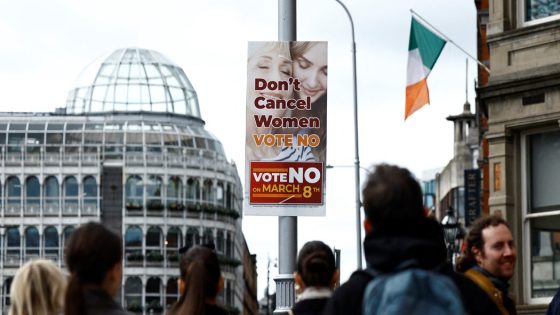In early February, as a referendum approached that had been called by Ireland’s coalition government to consider two proposals to alter the country’s Constitution, polls showed that a clear majority of voters intended to support it.
Many analysts assumed it would be the latest in a series of votes in recent years amending the country’s 1930s-era Constitution to reflect Ireland’s increasingly secular and liberal identity.
But as the day of the referendum, held to coincide with International Women’s Day, drew closer, public opinion seemed to turn, with polls showing support for the “yes” vote plummeting. When voters cast their ballots on Friday, they delivered a definitive “no” to both proposed amendments — one to change long-criticized language about women’s duties being in the home and another to broaden the definition of family beyond marriage.
The outcome dealt a blow to a government hoping for an easy victory. But the result, far from being evidence that conservative values were sweeping the nation, reflected a complex stew of factors that, analysts say, is likely to force government soul-searching: a weak campaign for the amendments, confusion over the proposals and lower-than-expected voter turnout.
In the end, the campaign in favor of the measures was rushed and disjointed, confusion reigned over the language presented in the proposals and less than half of eligible voters turned out to the polls.
Laura Cahillane, an associate professor at the University of Limerick’s law school, said that while some opposed the substance of the proposed changes, “the vast majority of people just really didn’t understand it,” in part because of an ineffective campaign to pass the proposals.
“They weren’t sure who to believe, because people were saying different things, and they weren’t sure what impact it would have, if any,” she said of the constitutional referendum. “If you’re changing the most basic law of our state and you can’t predict the consequences, people are just going to say, ‘Let’s leave it as it is because at least we know what that means.’”
The latest push to change the Constitution goes back to 2018, when a previous government suggested a vote to remove language on women’s “duties in the home” from the document. But rights groups had urged the government to slow things down and consider new language.
Eventually, in 2020 and 2021, a Citizens’ Assembly was convened on gender equality, bringing together members of the public to make recommendations. The group suggested specific wording for referendums, and a parliamentary committee later supported that language. Then, last December, the government confirmed its wording for the proposals.
“I think when the government actually published its wording, everyone was a little bit surprised,” Dr. Cahillane said. “There were people warning the government at that stage saying, you know, this wording has come out of nowhere and people aren’t very happy with this.”
The public was asked to vote on two questions. The first, on the Constitution’s Article 41, would have provided for a wider concept of family by replacing existing language to recognize a family, “whether founded on marriage or on other durable relationships, as the natural primary and fundamental unit group of society.”
The second question concerned wording in the Constitution that has been opposed for decades by women’s rights groups and those advocating gender equality: that the state “recognizes that by her life within the home, woman gives to the state a support without which the common good cannot be achieved.”
The wording also says that the state endeavors “to ensure that mothers shall not be obliged by economic necessity to engage in labor to the neglect of their duties in the home.”
The public voted against replacing that language with a new article that recognized all family caregivers, regardless of gender.
For many who supported reforming the provisions but were not happy with the actual proposals, it created a dilemma. All of Ireland’s major political parties eventually voting in favor of the proposals, as did trade unions, charities and equality groups, including the National Women’s Council and Ireland’s former president, Mary McAleese.
But there had been voices of concern from the start.
Many members of the political parties had endorsed the government’s plan to hold a vote but had serious reservations about then proposals’ language, and some charities that supported the changes had been early proponents of phrasing the proposals differently.
“I don’t know anyone who is happy with the government’s wording in these referendums,” Ursula Barry, an associate professor emeritus at University College Dublin, said in an opinion piece published in The Journal last week that advocated a “yes” vote. She added that the “government has created confusion.”
Dr. Barry, who was also an expert adviser to the Citizens’ Assembly, noted that advocates for people with disabilities and women’s rights organizations had wanted stronger wording that set out government obligations for providing support for caregivers.
As the vote loomed, there was limited campaigning in support of the proposals, even by the government and the other political parties who had endorsed a “yes” vote. And proponents had to campaign over a short time frame.
Orla O’Connor, the director of the National Women’s Council of Ireland, a charity promoting women’s rights and equality, said in a statement that the “government’s poor wording, combined with a lack of leadership from political parties, resulted in confusion amongst voters and a lack of mobilization on the ground.”
“We campaigned for a yes vote because we believed and continue to believe that Irish people value care and this was reflected in the earlier opinion polls,” she added. She said the wording in the proposal “did not go far enough and as the campaign evolved it was clear the public wanted more.”
In the end, nearly 68 percent of voters refused the changes on the family question, and almost three out of four voters opposed the care question.
The vote on care represented the highest ever percentage of “no” votes in the history of Irish referendums. And less than half of eligible voters — 44 percent — turned out, marked a significant drop from 2018, when the referendum on legalizing abortion drew nearly two-thirds of eligible voters.
“In the past referendums on big social issues, like abortion and same-sex marriage, you had a huge amount of organizations on the ground doing the campaigning,” Dr. Cahillane said. “You need that to happen, and the referendum didn’t have that happen this time.”
Unlike a 2015 referendum on marriage equality and the 2018 one on abortion, these latest proposals appeared to have had fewer practical implications for voters, she said.
Dr. Cahillane, who wrote extensively about the confusion around the referendum before the vote, said people who voted “no” represented a variety of perspectives across the political spectrum. Some were conservative voters, others were casting anti-government votes and some feared the changing the Constitution’s language would have a negative impact on a variety of issues.
But the major driver of the defeat was likely voters who struggled to parse the proposals and were more likely to reject change, she said, and the government did little to temper that.
“Of course, you have some people who oppose this for different reasons,” she said, adding, “But the vast majority of people just didn’t understand it.”
Source Agencies



